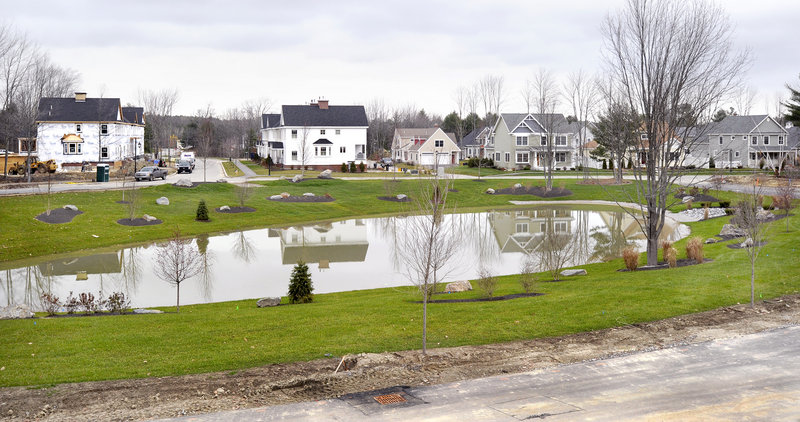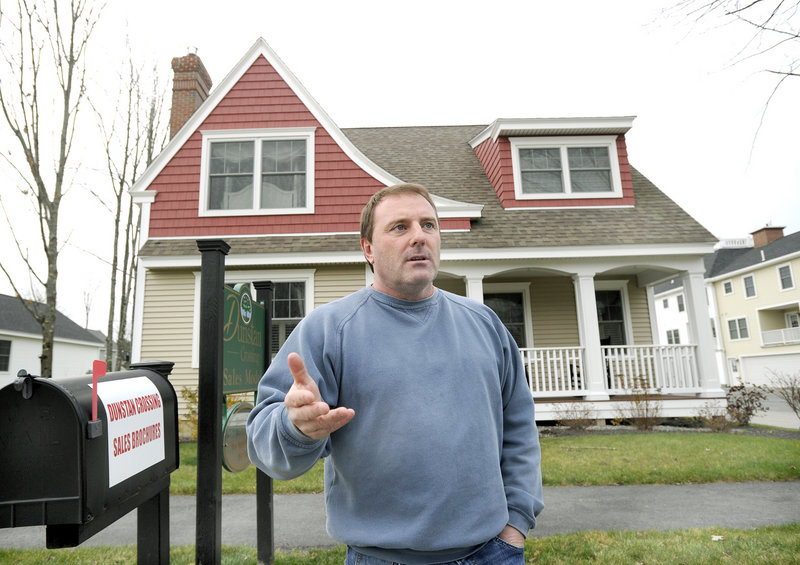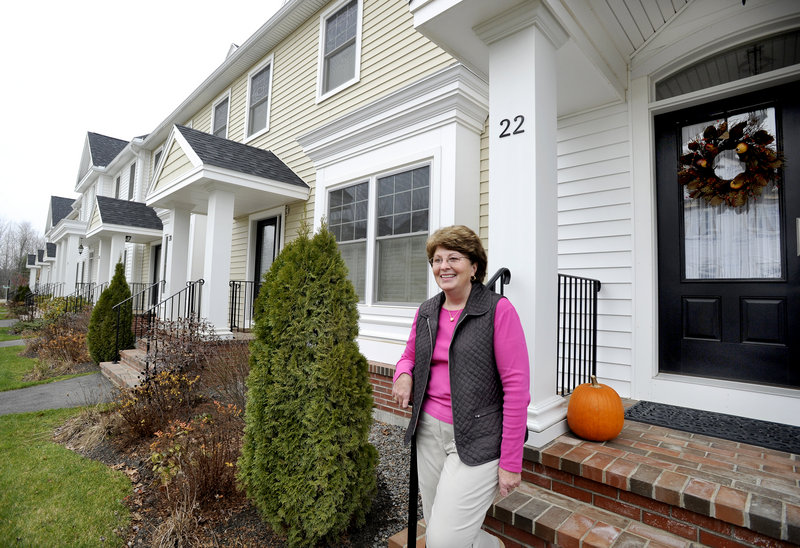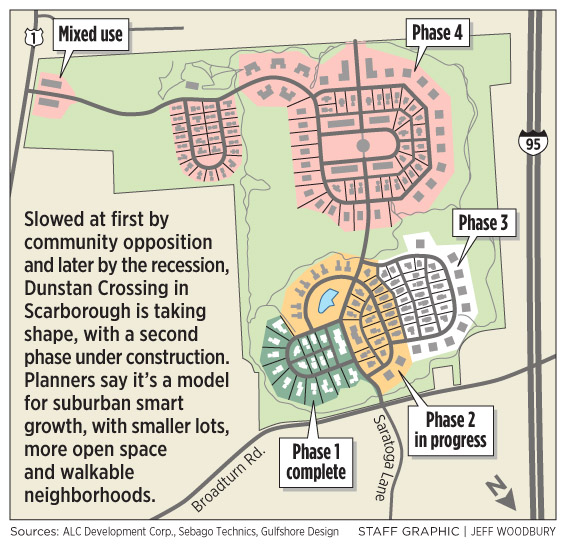SCARBOROUGH — Lynne Beal remembers growing up in Bangor in a neighborhood of children playing and riding bikes after school and on weekends. After raising her own family in Cape Elizabeth, she and her husband considered retiring to an adult community. Then they discovered Dunstan Crossing.
They moved last year to a new three-bedroom townhouse, among condos that are set in a neighborhood of single-family homes, with children playing and riding bikes. What at first resembled a remote suburban outpost to Beal has come to feel surprisingly familiar.
“Now, I can’t imagine not living here,” she said.
More than eight years have passed since Elliott Chamberlain first proposed an unprecedented 445-unit housing project here. Dubbed “the Great American Neighborhood,” it sought to blend single-family homes on smaller lots with rows of townhouses and commercial development, stitched together by sidewalks, wooded walking trails and parks.
Over the years, a divisive townwide referendum, a lawsuit and a deep recession scaled back and slowed Chamberlain’s plans. But as 2010 nears its end, the first phase of Dunstan Crossing is complete and work is under way on the next section.
Buyers like Lynne Beal are proving that the neighborhood Chamberlain envisioned is more than an abstract, “smart growth” proposal. On 120 acres of woodland off Broadturn Road, a model for 21st-century suburban development in southern Maine is starting to take shape.
Heavy equipment is building sidewalks that skirt a small pond, while contractors prepare six luxury townhomes across the street from Beal’s row. Single-family houses set on small lots re-create the feel of a traditional neighborhood. A backyard play set and driveway basketball hoops say children live here.
Larger estate homes ring the neighborhood, but they’re not the faux chateaus that stand isolated in old hayfields, on lots too large to mow but too small to farm. They stand on half-acre lots that feel connected to the village.
The general pattern will be repeated in subsequent phases, along with a mix of homes, stores and offices that will tie in Route 1. Build-out is likely 10 years away, depending on the economy.
A total of 13 single-family homes and 16 condos have been built or are under construction. Condo asking prices start at $350,000. Village homes range from $339,000 to $420,000. Estate lots start at $129,900.
Dunstan Crossing was conceived in 2000, after Chamberlain and his brother, John, went to a Maine State Planning Office seminar on smart growth. Embracing the concept, they began looking for land in southern Maine that was close to public sewerage and water. They hired a landscape architect, developed a plan and hashed it out with residents.
It was a period of rapid suburban expansion, and communities were enacting ordinances to slow growth. Dunstan Crossing would create Scarborough’s largest neighborhood. Opponents, worried about traffic and overcrowded schools, gathered enough signatures to force a special election, which overturned town approvals.
Chamberlain could have acquiesced and built 60 homes on 2-acre lots. Instead, he went to court and won, arguing that Scarborough had failed to follow its own comprehensive plan and create a zone for higher-density housing.
“We could have done 60 homes and been out of here a long time ago,” Chamberlain said. “But we really wanted to show that it could be done.”
A compromise trimmed the project to 288 homes. That turned out to be a blessing in disguise, Chamberlain acknowledged. His initial plan was just too big. But he won the option of building some extra units by agreeing to provide 10 affordable homes, through a deal that gives the town money to preserve open space.
Through the drawn-out process, Chamberlain has needed a big measure of financial patience. He invested about $1.6 million in the first phase, for instance, but slowly is starting to see the rewards.
“Look at what we’ve done in one of the worst economic downturns,” he said.
Chamberlain’s perseverance benefited Scarborough, said Dan Bacon, the town planner, by providing a model for future projects that embrace smart growth principles.
In the Oak Hill area, a 180-unit traditional neighborhood development called Eastern Village is under construction, featuring mixed housing, walking trails and energy-efficient design.
In time, Bacon said, Dunstan Crossing’s commercial expansion may help support a supermarket and other retail services along that stretch of Route 1, forming a service center that’s reachable on foot and bike.
Building homes close to businesses and public transportation routes is a priority for GrowSmart Maine, the Portland-based planning organization. The group is encouraging housing developments that reuse downtown buildings, such as the new Mill at Saco Falls project, in a renovated mill complex in Biddeford.
But not everyone wants to live downtown. As a suburban alternative, Dunstan Crossing has done a good job of integrating housing density, open space and a walkable community, said Nancy Smith, GrowSmart Maine’s executive director.
“They were out front when they started this, and that’s a gamble,” said Smith, who recently visited the project.
In the last two years, national events have combined to give an unexpected boost to Dunstan Crossing. The recession stunted overall home sales, but it also put the brakes on Hummer homes. With a variety of houses smaller than 2,500 square feet, Chamberlain has a product that’s in step with the times.
An aging population and the specter of another energy price shock also are raising the project’s profile in the market.
Sandra Murray and her husband own All Points Realtors in Scarborough, as well as a high-end modular construction company. Two miles from Dunstan Crossing, they’re developing Sea Ridge, a 56-home conservation subdivision, in which construction is concentrated to preserve open space.
Some buyers who explore Sea Ridge have looked at Dunstan Crossing, Murray said, and don’t like the idea of mixed housing, close together.
“But it’s definitely a unique product, and it’s causing people to consider options,” she said. “It’s causing people to say, ‘Should I consider that?’“
Staff Writer Tux Turkel can be contacted at 791-6462 or at: tturkel@pressherald.com
Send questions/comments to the editors.







Success. Please wait for the page to reload. If the page does not reload within 5 seconds, please refresh the page.
Enter your email and password to access comments.
Hi, to comment on stories you must . This profile is in addition to your subscription and website login.
Already have a commenting profile? .
Invalid username/password.
Please check your email to confirm and complete your registration.
Only subscribers are eligible to post comments. Please subscribe or login first for digital access. Here’s why.
Use the form below to reset your password. When you've submitted your account email, we will send an email with a reset code.